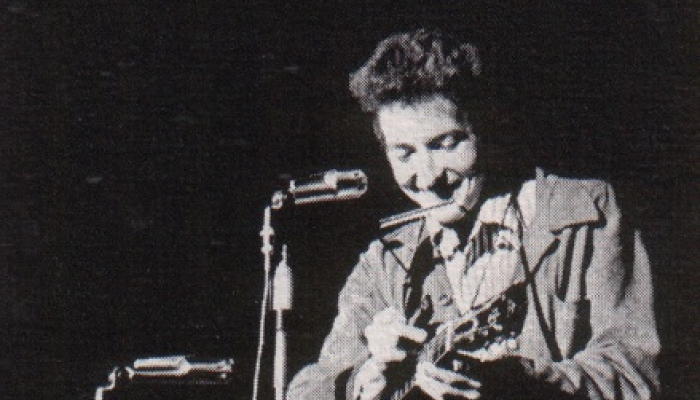Meetings that made music history… When Bob Dylan met The Beatles
The year is 1964. Beatlemania, in all its volcanic eruption, has spilled over the Atlantic, engulfing the United States. The “British invasion” has become an occupation.
Meanwhile, during a tour of France, the Fab Four were immersing themselves in the music of a growing phenomenon in that very land they had supposedly invaded. That phenomenon was Bob Dylan.

The Freewheelin’ Bob Dylan
A year earlier Bob Dylan had released the landmark album The Freewheelin’ Bob Dylan and had made a name for himself as an icon of the civil rights and anti-war movements, and as a figurehead of a burgeoning counterculture in the United States. Indeed, the opening track, The Times They Are A-Changin’, is widely seen as one of the most important anthems of the twentieth century.
Dylan’s fan base was not, however, confined to protester poets or tepid teetotallers in tan turtlenecks. The Beatles, constantly pursued by screaming hordes of teenage devotees, were great admirers of this album. This was to such an extent that George Harrison even stated that they listened to it so much that they “wore it out”, describing it as “incredibly original and wonderful”. In the words of John Lennon, the Scouse superstars “all went potty about Dylan.”
Two worlds collide
In fact, music historians have seen this meeting as coming at a crucial moment in both artists’ careers. Dylan, who had just released Another Side of Bob Dylan, was struggling with his status as anointed saint of a political movement he felt increasingly estranged from. This is encapsulated by the evergreen declaration of youthful naivety in My Back Pages, where the folk legend sings, “but I was so much older then, I’m younger than that now.”
Meanwhile, there was a parallel feeling of self-doubt within the Beatles, who looked both admiringly and perhaps enviously upon the introspective philosophising of the Minnesota-born folk star. Although undoubtedly their early work constitutes an incredibly important thread in the tapestry of music history, one cannot deny the contrasting intellectual and emotional universes occupied by the music of Dylan and the Beatles. As Jonathan Gould writes, the two artists were “perceived as inhabiting two separate subcultural worlds.”
New York, New York
This was the context for a very special debut encounter of these two monumental forces in the Delmonico Hotel in New York City. The meeting was arranged by music journalist Al Aronowitz; a curious figure who’s conspicuous standing in the annals of music history includes a stint as the first manager of legendary proto-punk group The Velvet Underground, led by none other than Lou Reed.
Packed into a hotel bedroom on Park Avenue and 59th, this legendary meeting of minds quickly degenerated into what Paul McCartney later described as a “crazy party” in which he thought he had truly understood “the meaning to life.” The sober reality dawned on him very quickly the morning after as Paul saw that on the night he had simply inscribed the words “there are seven levels” on a small paper note.
This perceived revelation, as Paul most likely soon realised, was not due to any wisdom imparted by their freewheeling new friend, but due to a certain “substance” that Dylan had introduced them to. Aronowitz would later boldly declare that “that meeting didn’t just change pop music – it changed the times.” Perhaps the musicians in the room may have given a slightly different account.
Crossing paths
Although the grand significance of this historic summit has in some cases been somewhat overstated, there is certainly much to say about the subsequent directions pursued by each artist following that eventful night. 1965 saw the release of Bringing It All Back Home, an upbeat rock-and-roll record that upset many of Dylan’s brooding coffee house following. The very same year, the Beatles released the softer, more acoustic, folk-influenced song “Norwegian Wood”.
Whilst the American folk superstar was drawn closer and closer to the limelight, reaching mainstream success with his 1966 hit “Like a Rolling Stone”, the Beatles ambitiously delved into new depths of experimentation with the extraordinarily successful album Sgt. Pepper’s Lonely Hearts Club Band.
Legacy
Perhaps, however, the meeting had more of an impact on some of the group than others. John Lennon certainly seemed intent on venturing far further afield than the days of “Love Me Do”and “Please Please Me”, and looked scornfully on McCartney’s often light-hearted, playful mentality. This couldn’t have been more evident in his rather brash description of Paul’s “Ob-La-Di, Ob-La-Da” as “granny music s***.” Maybe a bit harsh, John?
Fifty-five years on, no one in their right mind would even contemplate questioning the immense legacy of either of these two behemoths of modern music. In fact, the recent release of Martin Scorsese’s third in-depth documentary on the life of Bob Dylan is testament to his enduring relevance.
How much of that legacy was shaped by that fateful July evening will remain a source of controversy for music aficionados to pore over. The real question is: what would you give to be able go travel back in time to that meeting in a smoke-filled New York hotel room and be a witness to history in the making?
When looking for the ideal venue for your meeting, choose from our selection of affordable meeting rooms for hire. Call us today on 0800 073 0499 and discover how easy it is to book with us!
Guest blog by Jacob Tucker
Share this post
Tags
- Career Development
- Celebrity Meetings
- Conferences
- Confidence
- Exhibitions
- Historic Meetings
- How to Interview Effectively
- Human Resources
- In The Press
- Meetings and Conferences
- Monarchy
- News
- Our Team
- Personal Development
- Personnel
- Presentation Techniques
- Teamwork
- Top Tips for Meetings
- Training & Workshops
- Video Conferences



